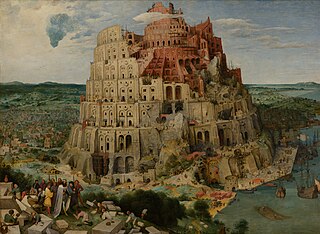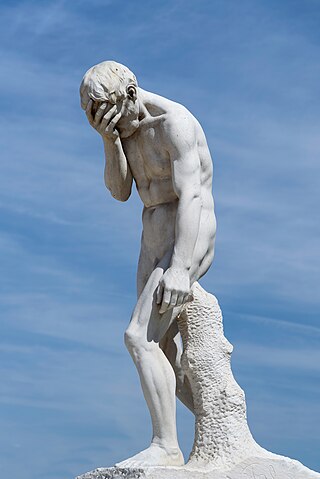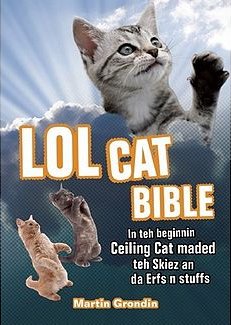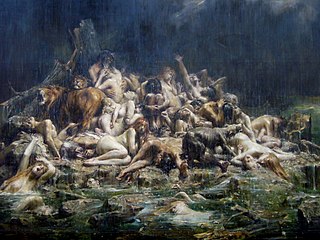
The Standard Works of the Church of Jesus Christ of Latter-day Saints are the four books that currently constitute its open scriptural canon. The four books of the standard works are:
The Old Testament (OT) is the first division of the Christian biblical canon, which is based primarily upon the 24 books of the Hebrew Bible or Tanakh, a collection of ancient religious Hebrew and occasionally Aramaic writings by the Israelites. The second division of Christian Bibles is the New Testament, written in the Koine Greek language.

The Tower of Babel narrative in Genesis 11:1–9 is an origin myth and parable meant to explain why the world's peoples speak different languages.

Cain is a Biblical figure in the Book of Genesis within Abrahamic religions. He is the elder brother of Abel, and the firstborn son of Adam and Eve, the first couple within the Bible. He was a farmer who gave an offering of his crops to God. However, God was not pleased and favored Abel's offering over Cain's. Out of jealousy, Cain killed his brother, for which he was punished by God with the curse and mark of Cain. He had several children, starting with Enoch and including Lamech.

Textual criticism is a branch of textual scholarship, philology, and literary criticism that is concerned with the identification of textual variants, or different versions, of either manuscripts (mss) or of printed books. Such texts may range in dates from the earliest writing in cuneiform, impressed on clay, for example, to multiple unpublished versions of a 21st-century author's work. Historically, scribes who were paid to copy documents may have been literate, but many were simply copyists, mimicking the shapes of letters without necessarily understanding what they meant. This means that unintentional alterations were common when copying manuscripts by hand. Intentional alterations may have been made as well, for example, the censoring of printed work for political, religious or cultural reasons.
The oldest surviving Hebrew Bible manuscripts—including the Dead Sea Scrolls—date to about the 2nd century BCE (fragmentary) and some are stored at the Shrine of the Book in Jerusalem. The oldest extant complete text survives in a Greek translation called the Septuagint, dating to the 4th century CE. The oldest extant manuscripts of the vocalized Masoretic Text, date to the 9th century CE.

Elohim, the plural of אֱלוֹהַּ, is a Hebrew word meaning "gods". Although the word is plural, in the Hebrew Bible it most often takes singular verbal or pronominal agreement and refers to a single deity, particularly the God of Israel. In other verses it refers to the singular gods of other nations or to deities in the plural.

The Joseph Smith Translation (JST), also called the Inspired Version of the Holy Scriptures (IV), is a revision of the Bible by Joseph Smith, the founder of the Latter Day Saint movement, who said that the JST/IV was intended to restore what he described as "many important points touching the salvation of men, [that] had been taken from the Bible, or lost before it was compiled". Smith died before he deemed it complete, though most of his work on it was performed about a decade beforehand. The work is the King James Version of the Bible (KJV) with some significant additions and revisions. It is considered a sacred text and is part of the canon of Community of Christ (CoC), formerly the Reorganized Church of Jesus Christ of Latter Day Saints, and other Latter Day Saint churches. Selections from the Joseph Smith Translation are also included in the footnotes and the appendix of the LDS-published King James Version of the Bible, but the Church of Jesus Christ of Latter-day Saints has only officially canonized certain excerpts that appear in its Pearl of Great Price. These excerpts are the Book of Moses and Smith's revision of part of the Gospel of Matthew.
The Book of Moses, dictated by Joseph Smith, is part of the scriptural canon for some denominations in the Latter Day Saint movement. The book begins with the "Visions of Moses", a prologue to the story of the creation and the fall of man, and continues with material corresponding to the Joseph Smith Translation of the Bible's (JST) first six chapters of the Book of Genesis, interrupted by two chapters of "extracts from the prophecy of Enoch".

Captain Victory is a comic book originally created, written and drawn by Jack Kirby. It was first published by American comic book publisher Pacific Comics in 1981. Kirby agreed to create a comic for the fledgling publisher because Pacific promised him full creative control, and ownership of the characters.

Religious satire is a form of satire that refers to religious beliefs and can take the form of texts, plays, films, and parody. From the earliest times, at least since the plays of Aristophanes, religion has been one of the three primary topics of literary satire, along with politics and sex. Satire which targets the clergy is a type of political satire, while religious satire is that which targets religious beliefs. Religious satire is also sometimes called philosophical satire, and is thought to be the result of agnosticism or atheism. Notable works of religious satire surfaced during the Renaissance, with works by Geoffrey Chaucer, Erasmus and Albrecht Dürer.
The Old Testament is the first section of the two-part Christian biblical canon; the second section is the New Testament. The Old Testament includes the books of the Hebrew Bible (Tanakh) or protocanon, and in various Christian denominations also includes deuterocanonical books. Orthodox Christians, Catholics and Protestants use different canons, which differ with respect to the texts that are included in the Old Testament.

The LOLCat Bible Translation Project was a wiki-based website set up in July 2007 by Martin Grondin, where editors aim to parody the entire Bible in "LOLspeak", the slang popularized by the LOLcat Internet phenomenon. The project relies on contributors to adapt passages. As of March 27, 2008, approximately 61% of the text had been adapted, and Grondin stated that he hoped the entire New Testament would be complete by the end of 2008.

Brian Teasley is an American musician, producer, writer, and entrepreneur from Alabama. He is a founding member of Man or Astro-man? (Birdstuff), and Servotron (Z4-OBX).

The Manga Bible: From Genesis to Revelation is an original English-language manga adaptation of the Bible created by British artist Ajinbayo "Siku" Akinsiku, who was responsible for the concept and the art and the script writer Akin Akinsiku. It was released in July 2007 by Galilee Trade. They summarize the narrative of the Bible in a 200-page graphic novel including the Old Testament and the New Testament. With their work, they combine the Western and the Japanese culture to tell the Bible in a new way. The book is especially aimed at readers between the ages of 15 to 25. Church representatives were praising the graphic novel, as opening up the ideas of the Bible to a new target group. Ajinbayo Akinsiku was born in England and grew up in Nigeria; he now lives again in England. He thus represents different cultures in his artistic work, which becomes also apparent in The Manga Bible. He became known for his work on 2000 AD and Judge Dredd.
The acknowledgement of Lego in popular culture is demonstrated by the toy's wide representation in publication, television and film, and its common usage in artistic and cultural works.

Ransom Riggs is an American writer and filmmaker best known for the book Miss Peregrine's Home for Peculiar Children.
Biblical translations into the indigenous languages of North and South America have been produced since the 16th century.

The Genesis flood narrative is a Hebrew flood myth. It tells of God's decision to return the universe to its pre-creation state of watery chaos and remake it through the microcosm of Noah's ark.
The following outline is provided as an overview of and topical guide to the Bible:















